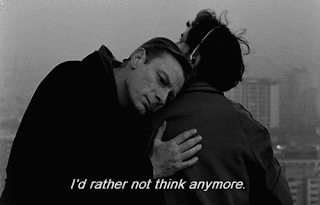Semiotics is the study of signs and symbols and is essential for communication, as it can often include facial expressions. Sassure founded the idea of semiotics and also came up with the idea of "the signifier and the signified". Charles Sanders Pierce later developed this with the idea of the "icon, index and symbol". The icon resembles what it stands for. The indexical sign refers to the senses, for example looking at a wet pavement we know it's been raining. The symbolic sign is thing we are culturally learnt, for example rose is symbolic for love.
Roland Barthes developed it further with his interpretation of connotation and denotation and signs in relation to myth. Denotation is the primary meaning and the connotation is what we gather and interpret from it.
We then had a look at some film posters and what they could reveal about the film. Lost in Translation was the best example for this, and Donnie Darko, which adds mystery to the film, not giving much away. We also had a look at some advertisements.
Barthes also had a theory of 5 codes;
Yea Rose is symbolic for love, it's obvious
http://www.radiotimes.com/uploads/images/original/84459.gif
Roland Barthes developed it further with his interpretation of connotation and denotation and signs in relation to myth. Denotation is the primary meaning and the connotation is what we gather and interpret from it.
We then had a look at some film posters and what they could reveal about the film. Lost in Translation was the best example for this, and Donnie Darko, which adds mystery to the film, not giving much away. We also had a look at some advertisements.
http://www.sharegif.com/wp-content/uploads/2013/11/Donnie-Darko-quotes-1.gif
Barthes also had a theory of 5 codes;
- Proairetic code - the sequence of events. We want to know what happens next.
- Hermeneutic code - where the story avoids telling the truth, witholding information from the viewer. Often happens in mystery, crime and detective films.
- Connotive or semic code - the deeper meaning. Object as a symbol or a metaphor. Often in surrealism (dream logic)
- Cultural or referential code - cultural references
- Symbolic code - binary opposites
http://bit.ly/2e7MKoY
There are also a few other codes in film;
- Dress codes - represents class, gender, age, employment, sexuality, status
- Colour codes - red=passion, etc
- Non-verbal codes - gesture, a 'look', body language
- Ethnicity/race codes - language, dress...
- Cultural codes - pop culture references
- Class codes - designer brands, money, dress, objects of desire
- Cinematic codes - angles, framing, type of shots
A handy book to look at is Semiotics: The Basics by Daniel Chandler (who also writes about 'the gaze'). Also, a note to myself, check out these films; Wings of Desire, Pleasantville (and also Adam Curtis).
https://66.media.tumblr.com/aea9e92e8237bb67b3c7664bee2b815f/tumblr_mjhc4kdRo61qiz3j8o1_500.gif
-----------------------------------------------------------------------------------------
Semiotics or realism?
Realism is aesthetic theory based on similarity or an identity between the photograph and depicting reality. A photograph is indexical (caused by it's own referent (what it refers to, indicates). The signifier (actual photograph) is the same as the signified (reality).
http://66.media.tumblr.com/acb3d3bbe31e754aa1ababa315c26b72/tumblr_mswmovcBjf1sytwjuo1_500.gif
Semiotics is distinction between the signifier and signified. The difference between what we see and the actual reality is not identical. Reality is constructed through codes and requires the spectator to give a signified meaning. We interpret the world as signs to be read: a paradigm shift into the way we think.
Semiotics was conceptualised in 1915 by Sassure but developed in 1960s with ideas of structuralism- the idea that thought can only exist within a system that necessitates, interrelations and reciprocation. We read signs in the world and treat everything as a text to be read. Visual culture is the signifiers and the concept we read is the signified.
https://s-media-cache-ak0.pinimg.com/564x/5d/33/84/5d3384b17d36f61d728108e88df29367.jpg
Labels are arbitrary and only corresponds to objects because we are culturally conditioned to recognise them. [insert some deep conversations about fonts and flags] (also this picture came up on the slides and made us laugh)
http://25.media.tumblr.com/tumblr_maduazyHZa1qasxjlo1_500.gif
A visual metaphor uses an image rater than words to make the comparison between one thing and another. A metonym is an image rather than words to make an association between two things. A symbolic image makes reference to something with a more literal meaning (a cross=a church). Advertising uses this a lot. Banksy has an antithesis (contrasts) and places opposites together to create new meanings.







No comments:
Post a Comment